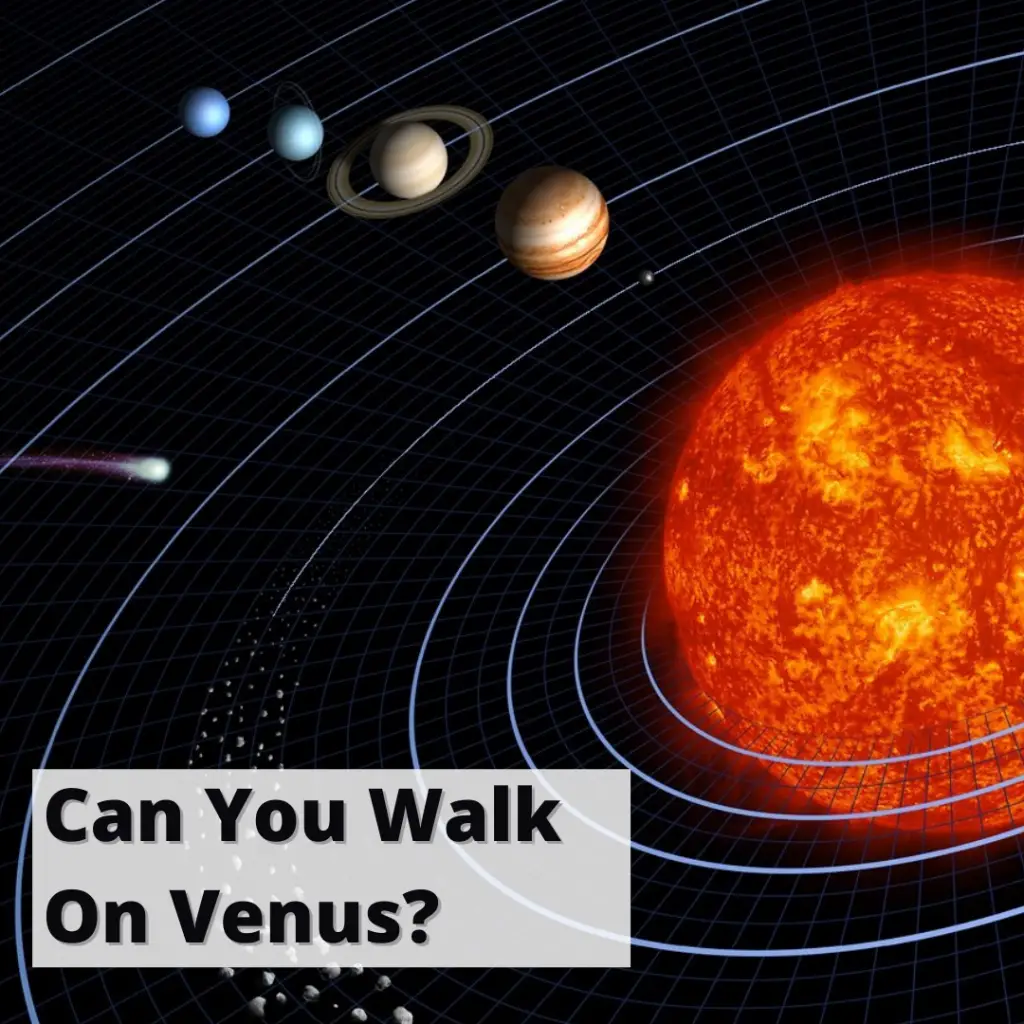While it seems maybe possible to walk on Venus, in reality, without serious technological advances, walking on Venus is really unlikely.
In the following article, we’ll explain.
Can You Walk On Venus? (EXPLAINED)
Introduction To Venus
Venus is the second closest planet to the sun in our solar system.
It is one of the four terrestrial planets, along with Mercury, Earth, and Mars.
It crust of Venus is solid and made mostly of basalt, while the core is thought to be made of iron.
Venus is extremely hot, partially because it is so close to the sun, and partially because Venus has a thick atmosphere.
The atmosphere is made of mostly carbon dioxide and 30 miles of clouds are composed of sulfuric acid.
This dense and toxic layer surrounding the planet traps heat, which means that even the side of the planet facing away from the sun remains warm (instead of becoming freezing, as Mercury does).
The temperature can exceed 800 degrees Fahrenheit, which is hot enough to melt some aluminum alloys, lead, tin, and zinc.
While the gravity on Venus is really similar to that on Earth, the air pressure is dramatically different.
As a result of the gravity plus the density of the atmosphere surrounding the planet, the air pressure on the surface of Venus is more than 90x the air pressure on the surface of Earth.
Humans can survive unaided up to around 50 psi.
The pressure in Venus is over 1300 psi.
This would be about the same pressure the human body would experience at about 3,000 feet under water on Earth.
What Are The Roadblocks To Walking On Venus?
There are multiple issues that would make it hard for humans to walk on Venus.
The one thing we would have going for us that several other planets do not is that the surface of the planet is solid.
This means that if you could overcome the other challenges, you’d actually be able to put your feet down on something solid.
Other planets (Jupiter, Saturn, Uranus, and Neptune) do not have a solid surface, making “walking” of any kind of the surface of the planet impossible no matter what.
But aside from the solid surface, Venus doesn’t have much else helpful going on.
The first challenge humans would have to overcome with technology is the incredible heat.
While many of the metals that we work with (steel, copper, iron, nickel, and titanium) would not melt at that temperature, most of the materials that we currently use in astronaut space suits would.
For example:
- nylon melts at just over 500 degrees Fahrenheit
- mylar melts at about 480 degrees Fahrenheit
- teflon melts at about 620 degrees Fahrenheit
- dacron melts at about 500 degrees Fahrenheit
Thus we could land on Venus in our metal ship, but stepping out of the ship without dying to take those first steps is currently not possible.
The next challenge is the air pressure.
While we can build ships that can withstand the air pressure that would exist on the surface of Venus, we don’t have any suits that we could put on our human astronauts that would allow them to leave the ship and survive the air pressure.
Some atmospheric suits used in diving could maybe get us close, but we’d still need some advances to overcome this challenge.
Finally, the sulfuric acid in the atmosphere would likely do some serious damage to the ship as well as the astronauts suits.
Sulfuric acid is pretty reactive and corrodes or even dissolves metals.
While the sulfuric acid might not have a chance to seriously damage the ship or the suits with a quick trip to the surface, it is something that could cause serious damage.
Oh, and it’s also really windy.
Oh, and don’t forget the radiation situation.
Venus is closer to the sun than Earth, and gets blasted with radiation.
While the cloud cover might block some of it, the crew and the ship would still have to deal with the exposure on the trip to the planet.
Needless to say, while it might technically be possible to take steps on Venus, without some serious technological advances, it is unlikely.
Did You Know? (Other Facts About Venus)
Here are some facts you may not have known about Venus:
- The carbon dioxide in the planet’s atmosphere probably resulted from volcanic activity.
- Venus rotates in the opposite direction of Earth. If you could see the sun through the toxic cover of clouds, the sun would rise in the west and set in the east.
- Venus was one of the first planets that received a visit from Earth spacecraft. In the early 1960s, Mariner 2 (NASA) flew by and sent back information.
- Russia has made successful landings on the surface of Venus. Not surprisingly, the craft did not survive for long. A US probe made it to the surface of Venus in the late 1970s and survived for about an hour.
- Venus rotates slowly. It takes 243 Earth days for Venus to spin around fully one time.
- Venus orbits the sun faster than Earth, taking around 225 Earth days to make the trip. Compare that to Mercury, which takes only 88 Earth days to orbit the sun one time.
- The clouds surrounding Venus probably smell like rotten eggs.
- The planet was named after the Roman goddess of love. This is quite interesting, considering that Venus is hot, toxic, obscured by clouds, exhibits extreme pressure, and is extremely likely to kill any many who dares approach her.
- Venus is close to the site of Earth, smaller by about 20%.
- Scientists opine that the planet may once have been habitable.
Wrap Up
Venus is a fascinating planet, and we look forward to learning more about it as the progress of space exploration continues.
You might also enjoy:







